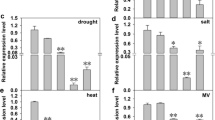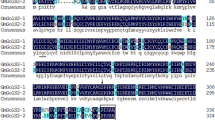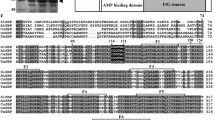Abstract
GDP-mannose pyrophosphorylase (GMPase: EC 2.7.7.22) plays a crucial role in the synthesis of l-ascorbate (AsA) and the consequent detoxification of reactive oxygen species (ROS). Herein, a GMPase (accession ID DQ449030) was identified and cloned from tomato. The full-length cDNA sequence of this gene contains 1,498 bp nucleotides encoding a putative protein with 361 amino acid residues of approximate molecular weight 43 kDa. Northern blot analysis revealed that the GMPase was expressed in all examined tomato tissues, but its expression level was up-regulated in tomato plants subjected to abnormal temperatures. We then overexpressed this tomato GMPase in tobacco plants and observed that the activity of GMPase and the content of AsA were significantly increased by two- to fourfold in the leaves of transgenic tobacco plants. The effect of this gene overexpression was superimposed by the treatments of high or low temperature in tobacco, since the activities of both chloroplastic SOD (superoxide dismutase EC 1.15.1.1), APX (ascorbate peroxidase EC 1.11.1.7) and the content of AsA in leaves were significantly higher in transgenic plants than those of WT, while the contents of H2O2 and O2 −· were reduced. Meanwhile, relative electric conductivity increased less in transgenic plants than that in WT, and the net photosynthetic rate (P n) and the maximal photochemical efficiency of PSII (F v/F m) of transgenic plants were notably higher than those of WT under temperature stresses. In conclusion, the overexpression of GMPase increased the content of AsA, thereby leading to the increase in tolerance to temperature stress in transgenic plants.







Similar content being viewed by others
Abbreviations
- APX:
-
Ascorbate peroxidase
- AsA:
-
l-Ascorbic acid
- Fv/Fm:
-
The maximal photochemical efficiency of PSII
- GMPase :
-
GDP-d-mannose pyrophosphorylase gene
- GMPase:
-
GDP-d-mannose pyrophosphorylase
- Pn:
-
Net photosynthetic rate
- PPFD:
-
Photosynthetic photon flux density
- ROS:
-
Reactive oxygen species
- SOD:
-
Superoxide dismutase
References
Asada K (1994) Production and action of active oxygen species in photosynthetic tissues. In: Foyer CH, Mullineaux PM (eds) Causes of photooxidative stress and amelioration of defense systems in plants. CRC Press, Boca Raton, pp 77–104
Asada K (1997) The role of ascorbate peroxidase and monodehydroascorbate reductase in H2O2 scavenging in plants. In: Scandalios JG (ed) Oxidative stress and the molecular biology of antioxidant defenses. Cold Spring Harbor Laboratory Press, New York, pp 715–735
Asada K (1999) The water–water cycle in chloroplasts: scavenging of active oxygens and dissipation of excess photons. Annu Rev Plant Physiol Plant Mol Biol 50:601–639
Asada K, Takahashi M (1987) Production and scavenging of active oxygen radicals in photosynthesis. In: Kyle DJ, Osmond CB, Arntzen CJ (eds) Photoinhibition, vol 9. Elsevier, Amsterdam, pp 227–288
Badejo AA, Tanaka N, Esaka M (2008) Analysis of GDP-d-mannose pyrophosphorylase gene promoter from acerola (Malpighia glabra) and increase in ascorbate content of transgenic tobacco expressing the acerola gene. Plant Cell Physiol 49:126–132
Bradford MM (1976) A rapid and sensitive method for the quantitation of microgram quantities of protein utilizing the principle of protein-dye binding. Anal Biochem 72:248–254
Chen Z, Gallie DR (2006) Dehydroascorbate reductase affects leaf growth, development and function. Plant Physiol 142:775–787
Conklin PL, Williams EH, Last RL (1996) Environmental stress sensitivity of an ascorbic acid-deficient Arabidopsis mutant. Proc Natl Acad Sci 93:9970–9974
Conklin PL, Pallanca JE, Last RL, Smirnoff N (1997) l-Ascorbic acid metabolism in the ascorbate deficient mutant vtc1. Plant Physiol 115:1277–1285
Conklin PL, Norris SR, Wheeler GL, Williams EH, Smirnoff N, Last RL (1999) Genetic evidence for the role of GDP-mannose in plant ascorbic acid (vitamin C) biosynthesis. Proc Natl Acad Sci 96:4198–4203
Foyer CH, Theodoulou FL, Delrot S (2001) The function of inter- and intracellular glutathione transport systems in plants. Trends Plant Sci 4:486–492
Giannopolitis CN, Ries SK (1977) Superoxide dismutases: I. Occurrence in higher plants. Plant Physiol 59:309–314
Horemans N, Foyer CH, Potters G, Asard H (2000) Ascorbate function and associated transport system in plants. Plant Physiol Biochem 38:531–540
Horsch RB, Fry JE, Hoffmann NL, Eichholtz D, Rogers SG, Fraley RT (1985) A simple and general method for transferring gene into plants. Science 227:1229–1231
Huang CH, He WL, Guo JK, Chang XX, Su PX, Zhang LX (2005) Increased sensitivity to salt stress in an ascorbate-deficient Arabidopsis mutant. Exp Bot 56:3041–3049
Jiménez A, Hernández JA, De1 Rio LA, Sevilla F (1997) Evidence for the presence of the ascorbate–glutathione cycle in mitochondria and peroxisomes of pea leaves. Plant Physiol 114:275–284
Kampfenkel K, Van Montagu M, Inze′ D (1995) Extraction and determination of ascorbate and dehydroascorbate from plant tissue. Anal Biochem 225:165–167
Keller R, Springer F, Renz R, Kossmann J (1999) Antisense inhibition of the GDP-mannose pyrophosphorylase reduces the ascorbate content in transgenic plants leading to developmental changes during senescence. Plant J 19:131–141
Laemmli UK (1970) Cleavage of structural proteins during the assembly of the head of bacteriophage T4. Nature 227:680–685
Li XG, Meng QW, Jiang GQ, Zou Q (2003) The susceptibility of cucumber and sweet pepper to chilling under low irradiance is related to energy dissipation and water-water cycle. Photosynthetica 41:259–265
Lim S, Kim YH, Kim SH, Kwon SY, Lee HS, Kim JS, Cho KW, Pack KY, Kwak SS (2007) Enhanced tolerance of transgenic sweetpotato plants that express both CuZnSOD and APX in chloroplasts to methyl viologen-mediated oxidative stress and chilling. Mol Breed 19:227–239
Mahajan S, Tuteja N (2005) Cold, salinity and drought stresses: an overview. Arch Biochem Biophys 444:139–158
Mano J, Ushimaru T, Asada K (1997) Ascorbate in thylakoid lumen as an endogenous electron donor to photosystem II: protection of thylakoids from photoinhibition and regeneration of ascorbate in stroma by dehydroascorbate reductase. Photosynth Res 53:197–204
Miller G, Shulaev V, Mittler R (2008) Reactive oxygen signaling and abiotic stress. Physiol Plant 133:481–489
Noctor G, Foyer CH (1998) Ascorbate and glutathione: keeping active oxygen under control. Annu Rev Plant Physiol Plant Mol Biol 49:249–279
Robinson SP, Downton WJS, Millhouse JA (1983) Photosynthesis and ion content of leaves and isolated chloroplasts of salt-stressed spinach. Plant Physiol 73:238–242
Sairam PK, Srivastava GC (2002) Changes in antioxidant activity in sub-cellular fractions of tolerant and susceptible wheat genotypes in response to long term salt stress. Plant Sci 162:897–904
Sambrook J, Fritsch EF, Maniatis T (1989) Molecular cloning: a laboratory manual, 2nd edn. Cold Spring Harbor Laboratory Press, Cold Spring Harbor
Sanmartin M, Drogoudi PD, Lyons T, Pateraki I, Barnes J, Kanellis AK (2003) Over-expression of ascorbate oxidase in the apoplast of transgenic tobacco results in altered ascorbate and glutathione redox states and increased sensitivity to ozone. Planta 216:918–928
Smirnoff N (2000) Ascorbic acid: metabolism and functions of a multi-facetted molecule. Curr Opin Plant Biol 3:229–235
Song XS, Hu WH, Mao WH, Ogweno JO, Zhou YH, Yu JQ (2005) Response of ascorbate peroxidase isoenzymes and ascorbate regeneration system to abiotic stresses in Cucumis sativus L. Plant Physiol Biochem 43:1082–1088
Szumilo T, Drake RR, York JL, Elbein AD (1993) GDP-mannose pyrophosphorylase. Purification to homogeneity, properties, and utilization to prepare photoaffinity analogs. J Biol Chem 268:17943–17950
Takahashi MA, AsAda K (1983) Superoxide anion permeability of phospholipid membranes and chloroplast thylakoids. Arch Biochem Biophys 226:558–566
Van KO, Snel JFH (1990) The use of chlorophyll fluorescence nomenclature in plant stress physiology. Photosynth Res 25:147–150
Wang AG, Luo GH (1990) Quantitative relation between the reaction of hydroxylamine and superoxide anion radicals in plants. Plant Physiol Commun 6:55–57
Yang XH, Wen XG, Gong HM, Lu QT, Yang ZP, Tang YL, Liang Z, Lu CM (2007) Genetic engineering of the biosynthesis of glycinebetaine enhances thermotolerance of photosystem II in tobacco plants. Planta 225:719–733
Zou LP, Li HX, Ouyang B, Zhang JH, Ye ZB (2006) Cloning and mapping of genes involved in tomato ascorbic acid biosynthesis and metabolism. Plant Sci 170:120–127
Acknowledgments
We thank Professor Qingwei Meng for the technical assistance during antibody preparation and Northern blotting. This work was supported by Grants from National Basic Research Program of China (973 Program) (2009CB119000)and National Natural Science Foundation of China (no. 3077147).
Author information
Authors and Affiliations
Corresponding author
Additional information
Communicated by K. Chong.
Rights and permissions
About this article
Cite this article
Wang, HS., Yu, C., Zhu, ZJ. et al. Overexpression in tobacco of a tomato GMPase gene improves tolerance to both low and high temperature stress by enhancing antioxidation capacity. Plant Cell Rep 30, 1029–1040 (2011). https://doi.org/10.1007/s00299-011-1009-y
Received:
Revised:
Accepted:
Published:
Issue Date:
DOI: https://doi.org/10.1007/s00299-011-1009-y




